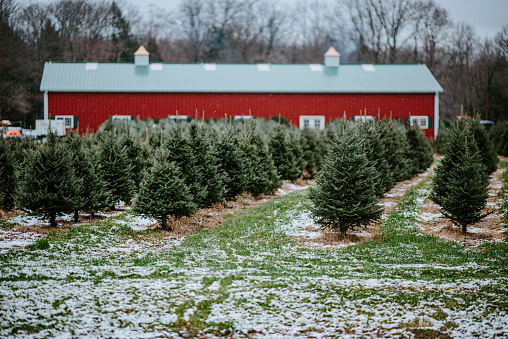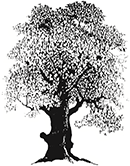MAINE-LY GARDENING: What’s in the House? Oh, Christmas Tree

 by Jude Hsiang
by Jude Hsiang
When the family gathers for the holidays, we often look through the photo albums and reminisce. Look at pictures of your Christmas trees over the years. Decorated with ornaments, lights, and garlands, and surrounded by gifts, children and pets, the tree itself is hardly visible, but we remember its fragrance, as well as the happy faces around it.
In recent decades, our Christmas trees are generally farmed and groomed to become full green cones. But If you look at photos from the 1950s and earlier, the difference is striking. The branches back then were more widely spaced, and the needles were pretty sparse compared to the tree you may be looking for this holiday season. Those trees from years gone by looked like the firs we see in the woods. Some folks still go out to the woodlot to find a tree, but many of us will buy one from a nearby Christmas tree farm, which may also sell wreaths, garlands, and more. Santa might be there to greet you.
As 14-year-old, a friend won a 4-H award for his chickens – a handful of balsam tree seedlings. Seventy years later, he, his son, and staff grow seven species of Christmas trees in addition to balsam firs – the traditional favorite of New Englanders – on 20 acres. Years ago it wasn’t unusual for some people to get their start in the Christmas tree business by digging or even pulling little fir seedlings in the woods in early spring to transplant on a north-facing slope. In seven years, the little trees would reach saleable height. (The same length of time it takes a lobster to reach your plate.)
Most Christmas tree farmers purchase 2- to 4-year-old seedlings from other farms and nurseries where trees are started from seed, transplanted as babies to the field, and finally sold in bundles to be grown to full size. As they grow the trees are carefully pruned to shape each year. There has been some resistance to “perfect” Christmas trees in recent years, as some customers prefer a more natural look. Whatever species, size and shape you want, the annual search for the right tree is a tradition.
Many growers belong to their regional Christmas tree farm association and also rely on their Cooperative Extension Service to keep up to date on trends in the market, and information on any threats to the crop from diseases, pests, and weather. The farmers may have a choose-and-cut operation, raise trees to be trucked to city markets, or a combination.
The Maine Christmas Tree Association has some useful tips for the customers, too. Like most plants, a Christmas tree is more than half water, and you’ll want to keep it fresh as long as possible in the warm, dry house after it’s become used to the cold during the fall. It’s best to have a stand that will hold about a quart of water for every inch of diameter of the trunk of the tree. Make a fresh ½ inch cut before putting it in the stand and check each day to be sure there’s still a good amount of water. Don’t trim off the bark or drill holes in the base. That won’t help the tree take up water, and it will damage the outer layers next to bark that do the work of moving water through the tree.
There’s more to think about such as keeping the tree away from heat sources and checking that lights are not going to add heat. It’s amazing to think that people used to regularly put lit candles on Christmas trees! Safety conscious folks turn off the lights before bedtime or if they are going out during the day.
Christmas tree growers remind us that natural trees are better for the environment. Among other benefits, real trees can be recycled. Once the holidays are over you can use the tree as mulch or start a wood pile that will shelter birds and small critters from the cold. Many towns now use the trees in various ways and encourage your help by offering streetside collection or designating drop-off spots.
If you have friends with goats, ask them if they’d like your used tree. – as long as it hasn’t been sprayed with any paint, artificial snow, or other inedible treatment. Goats love a post-Christmas snack!
© Judith Chute Hsiang
Jude Hsiang is a retired Extension Master Gardener instructor and member of the China Community Garden.
Responsible journalism is hard work!
It is also expensive!
If you enjoy reading The Town Line and the good news we bring you each week, would you consider a donation to help us continue the work we’re doing?
The Town Line is a 501(c)(3) nonprofit private foundation, and all donations are tax deductible under the Internal Revenue Service code.
To help, please visit our online donation page or mail a check payable to The Town Line, PO Box 89, South China, ME 04358. Your contribution is appreciated!


Leave a Reply
Want to join the discussion?Feel free to contribute!